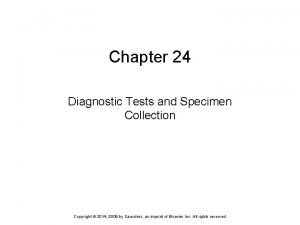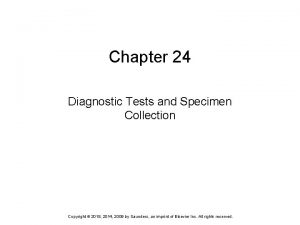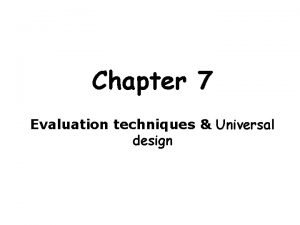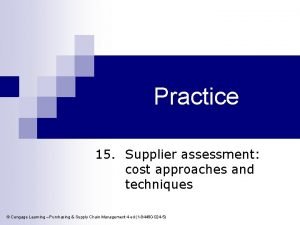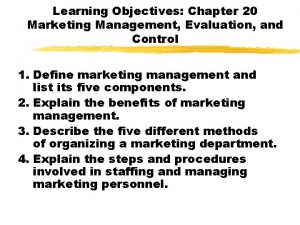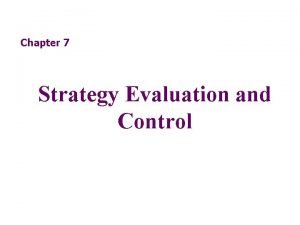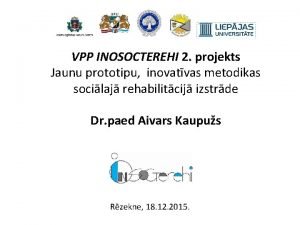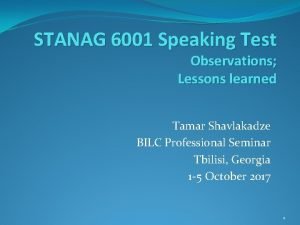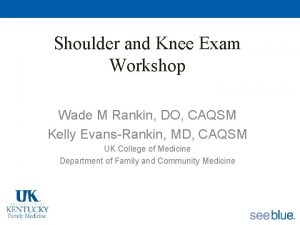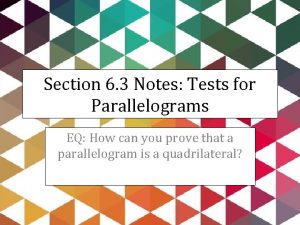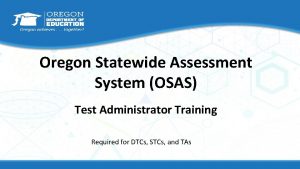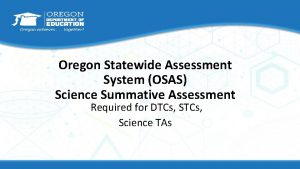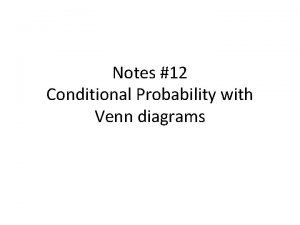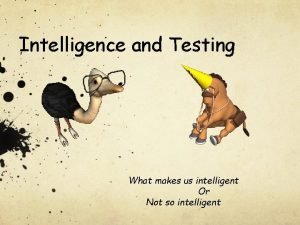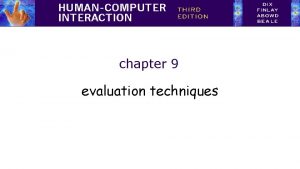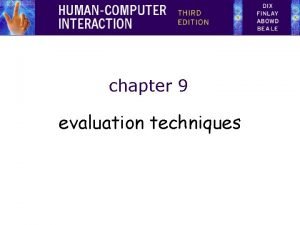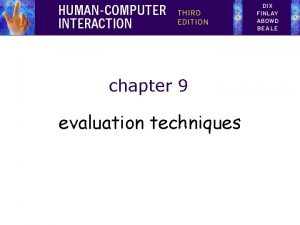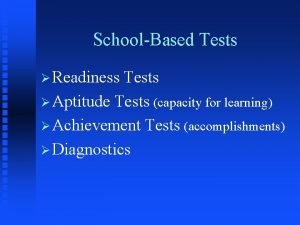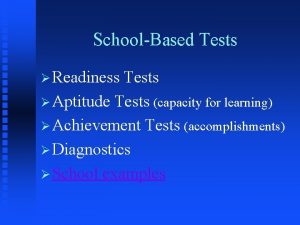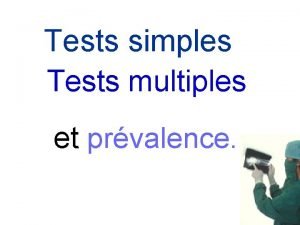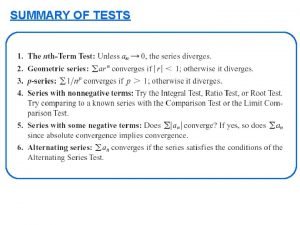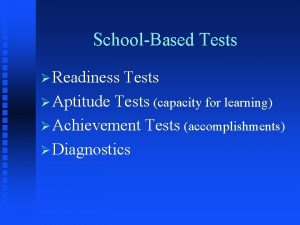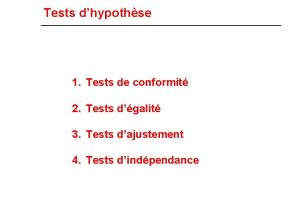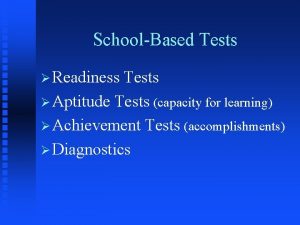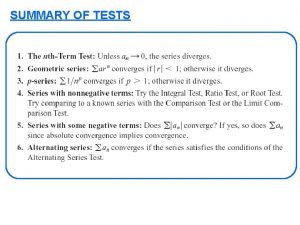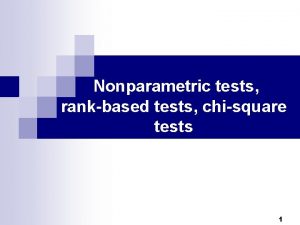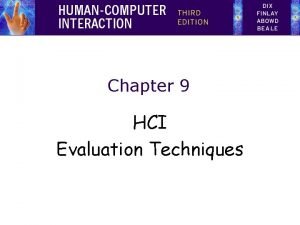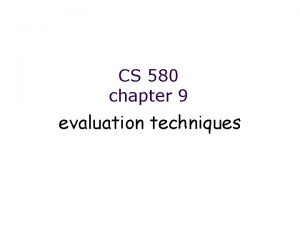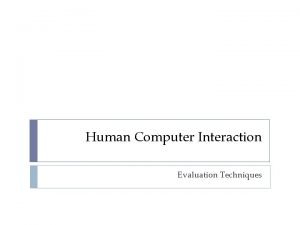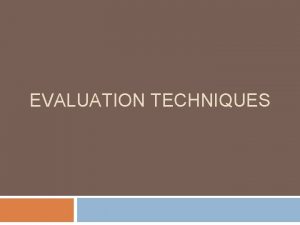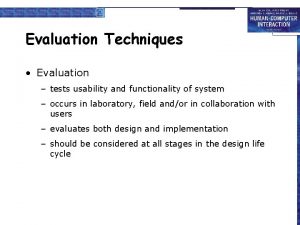chapter 9 evaluation techniques Evaluation Techniques Evaluation tests








































- Slides: 40

chapter 9 evaluation techniques

Evaluation Techniques • Evaluation – tests usability and functionality of system – occurs in laboratory, field and/or in collaboration with users – evaluates both design and implementation – should be considered at all stages in the design life cycle

Goals of Evaluation • assess extent of system functionality • assess effect of interface on user • identify specific problems

Evaluating Designs-Expert Analysis aims to identify areas that are likely to cause difficulties because they violate known cognitive rules or accepted empirical results • Cognitive Walkthrough • Heuristic Evaluation • Review-based evaluation

Cognitive Walkthrough Proposed by Polson et al. – Detailed review of a sequence of actions – Review steps that an interface requires from user to accomplish known task – Usually focus is how easy the system is learned-exploratory learning – evaluates design on how well it supports user in learning task – usually performed by expert in cognitive psychology – expert ‘walks though’ design to identify potential problems using psychological principles – forms used to guide analysis

Cognitive Walkthrough (ctd) • • To perform walkthrough, you need: Specification or prototype of the system Description of the task Complete, written list of actions needed to complete the task • Knowledge about users’ experience so that evaluators can assume about them

Cognitive Walkthrough (ctd) • For each task walkthrough considers – what impact will interaction have on user? : Is effect created by interaction is the same as what user is trying to achieve? – Will users see the button or menu item required for the action? -visibility – Will users know the item’s meaning? – Will user know he manage to achieve the correct action? feedback – what cognitive processes are required? – what learning problems may occur? • Analysis focuses on goals and knowledge: does the design lead the user to generate the correct goals?

Cognitive Walkthrough (ctd)

Cognitive Walkthrough (ctd)

Cognitive Walkthrough (ctd)

Heuristic Evaluation • Heuristics: guideline or general principle or rule of thumb that can guide design decision or critique a decision of design • Can be performed on a design specification, also on prototypes, storyboards and fully functional systems • Flexible, cheap approach

Heuristic Evaluation • usability criteria (heuristics) are identified • design examined by experts to see if these are violated • 3 -5 evaluators 75% of usability problems discovered • Each evaluator assesses the system and notes violations of the heuristics • Evaluator also assesses the severity of the problem based on: how common is the problem; how easy it is to overcome; how seriously it is perceived? • Evaluators rate on a scale 0 -4 O: I don’t agree this is a usability problem at all ……. 4: Usability catastrophe: imperative to fix it

Heuristic Evaluation

Heuristic Evaluation

Heuristic Evaluation • Heuristic evaluation `debugs' design. • Once each evaluator has completed their separate assessment, all of the problems are collected and the mean severity ratings calculated. • The design team will then determine the ones that are the most important and will receive attention first.

Review-based evaluation • Results from the literature used to support or refute parts of design. • Care needed to ensure results are transferable to new design. • Model-based evaluation –cognitive and design models • cognitive model- GOMS model to predict user performance • Lower-level modelling techniques- keystroke-level model predicts time required for low level physical activities • Design rationale can also provide useful evaluation information

Evaluating through user Participation

Laboratory studies • Advantages: – specialist equipment available – uninterrupted environment • Disadvantages: – lack of context – difficult to observe several users cooperating • Appropriate – if system location is dangerous or impractical for constrained single user systems to allow controlled manipulation of use

Field Studies • Advantages: – natural environment – context retained (though observation may alter it) – longitudinal studies possible • Disadvantages: – distractions – noise • Appropriate – where context is crucial for longitudinal studies

Evaluating Implementations Requires an artefact: simulation, prototype, full implementation

Experimental evaluation • controlled evaluation of specific aspects of interactive behaviour • evaluator chooses hypothesis to be tested • a number of experimental conditions are considered which differ only in the value of some controlled variable. • changes in behavioural measure attributed to different conditions

Experimental factors • Subjects – who – representative, sufficient sample • Variables – things to modify and measure • Hypothesis – what you’d like to show • Experimental design – how you are going to do it

Variables • independent variable (IV) characteristic changed to produce different conditions e. g. interface style, number of menu items • dependent variable (DV) characteristics measured in the experiment e. g. time taken, number of errors.

Hypothesis • prediction of outcome – framed in terms of IV and DV e. g. “error rate will increase as font size decreases” • null hypothesis: – states no difference between conditions – aim is to disprove this e. g. null hyp. = “no change with font size”

Experimental design • within groups design – each subject performs experiment under each condition. – transfer of learning possible – less costly and less likely to suffer from user variation. • between groups design – – each subject performs under only one condition no transfer of learning more users required variation can bias results.

Analysis of data • Before you start to do any statistics: – look at data – save original data • Choice of statistical technique depends on – type of data – information required • Type of data – discrete - finite number of values – continuous - any value

Observational Methods Think Aloud Cooperative evaluation Protocol analysis Automated analysis Post-task walkthroughs

Think Aloud • user is observed performing task • user asked to describe what he is doing and why, what he thinks is happening etc. • Advantages – simplicity - requires little expertise – can provide useful insight – can show system is actually use • Disadvantages – Subjective – Selective for the task chosen – act of describing may alter task performance

Cooperative evaluation • variation on think aloud • user collaborates in evaluation • both user and evaluator can ask each other questions throughout • Additional advantages – less constrained and easier to use – user is encouraged to criticize system – clarification possible

Protocol analysis • Record of an evaluation session: protocol • paper and pencil – cheap, limited to writing speed • audio – good for think aloud, difficult to match with other protocols • video – accurate and realistic, needs special equipment, obtrusive • computer logging – automatic and unobtrusive, large amounts of data difficult to analyze • user notebooks – coarse and subjective, useful insights, good for longitudinal studies • Mixed use in practice. • audio/video transcription difficult and requires skill. • Some automatic support tools available

automated analysis – EVA • automatic support tool • Advantages – analyst has time to focus on relevant incidents – avoid excessive interruption of task • Disadvantages – lack of freshness – may be post-hoc interpretation of events

post-task walkthroughs • transcript played back to participant for comment – immediately fresh in mind – delayed evaluator has time to identify questions • useful to identify reasons for actions and alternatives considered • necessary in cases where think aloud is not possible

Query Techniques Interviews Questionnaires

Interviews • analyst questions user on one-to -one basis usually based on prepared questions • informal, subjective and relatively cheap • Advantages – can be varied to suit context – issues can be explored more fully – can elicit user views and identify unanticipated problems • Disadvantages – very subjective – time consuming

Questionnaires • Set of fixed questions given to users • Advantages – quick and reaches large user group – can be analyzed more rigorously • Disadvantages – less flexible – less probing

Questionnaires (ctd) • Need careful design – what information is required? – how are answers to be analyzed? • Styles of question – – – general open-ended scalar multi-choice ranked

Physiological methods Eye tracking Physiological measurement

eye tracking • head or desk mounted equipment tracks the position of the eye • eye movement reflects the amount of cognitive processing a display requires • measurements include – fixations: eye maintains stable position. Number and duration indicate level of difficulty with display – saccades: rapid eye movement from one point of interest to another – scan paths: moving straight to a target with a short fixation at the target is optimal

physiological measurements • emotional response linked to physical changes • these may help determine a user’s reaction to an interface • measurements include: – – heart activity, including blood pressure, volume and pulse. activity of sweat glands: Galvanic Skin Response (GSR) electrical activity in muscle: electromyogram (EMG) electrical activity in brain: electroencephalogram (EEG) • some difficulty in interpreting these physiological responses - more research needed

Choosing an Evaluation Method when in process: design vs. implementation style of evaluation: laboratory vs. field how objective: subjective vs. objective type of measures: qualitative vs. quantitative level of information: high level vs. low level of interference: obtrusive vs. unobtrusive resources available: time, subjects, equipment, expertise
 Iq intelligence
Iq intelligence Chapter 23 specimen collection and diagnostic testing
Chapter 23 specimen collection and diagnostic testing Chapter 20 more about tests and intervals
Chapter 20 more about tests and intervals Chapter 24 diagnostic tests and specimen collection
Chapter 24 diagnostic tests and specimen collection Portfolio evaluation techniques
Portfolio evaluation techniques Molich
Molich Evaluation techniques
Evaluation techniques Theoretical evaluation of overflow techniques
Theoretical evaluation of overflow techniques Cost approach and techniques in supplier assessment
Cost approach and techniques in supplier assessment Marketing evaluation techniques
Marketing evaluation techniques Evaluation techniques for operational control
Evaluation techniques for operational control Fonction technique scooter
Fonction technique scooter Wigan lea mental maths
Wigan lea mental maths Bod apes
Bod apes Romberga tests
Romberga tests The dirty mind test
The dirty mind test Number sense uil
Number sense uil Uil calculator practice tests
Uil calculator practice tests Mechanical reasoning test
Mechanical reasoning test Shrek ordinary world
Shrek ordinary world Univariate statistical tests
Univariate statistical tests Stanag 6001 tests download
Stanag 6001 tests download Tea dccr
Tea dccr Identification type of test sample
Identification type of test sample Yergason test
Yergason test 6-3 tests for parallelograms answer key
6-3 tests for parallelograms answer key Inkblots definition
Inkblots definition Qualitative and quantitative test for lipids
Qualitative and quantitative test for lipids Provincial achievement tests
Provincial achievement tests Presumptive vs confirmatory tests
Presumptive vs confirmatory tests Premarital tests or assessments
Premarital tests or assessments Prayers before exams
Prayers before exams Osas testing portal
Osas testing portal Osas science
Osas science Mutually exclusive venn diagram example
Mutually exclusive venn diagram example Lab tests for anemia
Lab tests for anemia Parametric and nonparametric tests
Parametric and nonparametric tests 8.3 proving parallelograms worksheet answers
8.3 proving parallelograms worksheet answers Achievement vs aptitude tests ap psychology
Achievement vs aptitude tests ap psychology Intelligence tests are “biased” in the sense that
Intelligence tests are “biased” in the sense that Eqao practice test
Eqao practice test

